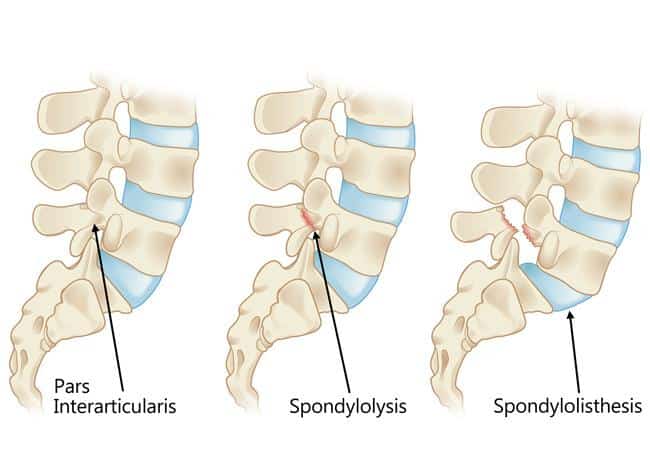Spondylolisthesis: Symptoms & Treatment
What is Spondylolisthesis?
Spondylolisthesis is a common lower back problem where one vertebra slips in front of vertebrae that sits below it, often resulting in vertebrae misalignment.
Types of Spondylolisthesis
There are two main types of spondylolisthesis, Degenerative and Isthmic. The cause of these two types of spondylolisthesis are what differentiates the two. For the most part the symptoms, diagnosis, conservative treatments, and surgical solutions are the same.
Photo from OrthoInfo
Degenerative spondylolisthesis most commonly happens at the fourth and fifth lumbar vertebra (L4-5). It is the result of disc degeneration, arthritis in the spine, and the laxity of the ligaments that help stabilize the spine.
Isthmic spondylolisthesis is most commonly at seen at the fifth lumbar vertebrae and first sacral segment (L5-S1).
What Are The Symptoms of Spondylolisthesis?
The particular type of spondylolisthesis can often dictate specific symptoms that a patient can present with. Symptoms include but aren’t limited to:
- Back pain: this is the most common symptom.
- Leg pain: can be caused by compression of specific nerves in the back.
- Neurogenic claudication: this is the sensation of the patient’s legs feeling “tired” or having discomfort particularly when they exert themselves. Patients will often say that they feel better when the stop and sit down or if they have something to lean on such a grocery cart. This is commonly called the “shopping cart” sign.
- If the nerve compression is very severe, it can cause loss of bowel or bladder control. This is referred to as cauda equina syndrome and is a surgical emergency. Any patient with these symptoms should go immediately to the nearest emergency room.
How Is Spondylolisthesis Diagnosed?
As with all orthopedic problems, spondylolisthesis is diagnosed by an appropriate intake of history a physical exam and imaging modalities. Specific images can include:
- X-rays
- CT scans
- MRIs.
Commonly, your surgeon will ask you to take X-rays while bending slightly forward and slightly backwards (flexion and extension films). This is done to assess how much a patient’s vertebrae is moving, which can further dictate treatment.
What Are The Risk Factors Associated With Spondylolisthesis?
Many of the risk factors associated with degenerative spondylolisthesis are non-modifiable or things that a patient cannot change or control such as age, genetic predisposition and injuries.
Those At Risk To Have Spondylolisthesis
Degenerative spondylolisthesis is more commonly seen in:
- Women more than in men
- Individuals over 40 years old
- African Americans
- Diabetic Individuals.
Isthmic spondylolisthesis is commonly seen in patients who participate in repetitive hyperextension exercises. For example, weightlifters, gymnasts and football players (most often linemen).
What Are The Treatment Options For Spondylolisthesis?
There are several nonoperative or conservative treatment options for spondylolisthesis.
- Lifestyle modifications
- Rest
- Physical therapy
- Oral medications such as non-steroidal anti-inflammatories (NSAIDS)
- Short course of bracing
- Injections
The surgical treatment options for spondylolisthesis are often tailored to the patient’s specific symptoms and post-operative goals. Consideration is also given to the patient’s medical history, weight and any previous spine or abdominal surgery.
Can Spondylolisthesis Be Reversed or Prevented?
As mentioned, there are several risk factors that patients cannot change or reverse. However, maintaining a healthy and active lifestyle and appropriate weight is an excellent way to help prevent the beginning stages of spondylolisthesis as well as many other orthopedic issues.

Meet Dr. Vincent Buddle
Dr. Vincent Buddle is a fellowship trained orthopaedic spine surgeon having completed his training and residency at Rowan University School of Osteopathic Medicine in Stratford, New Jersey. Dr. Buddle specializes in the treatment of back pain and spinal disorders focusing mainly on degenerative conditions, including cervical and lumbar radiculopathy, myelopathy, disc herniations, and spinal stenosis as well as traumatic injuries to the spine.


